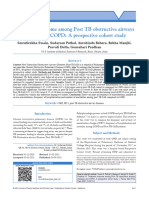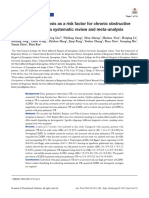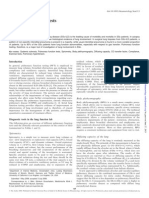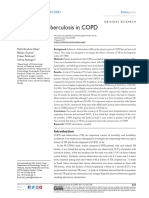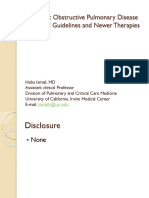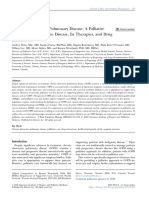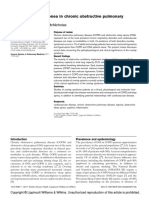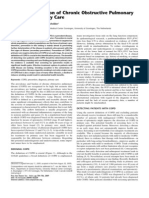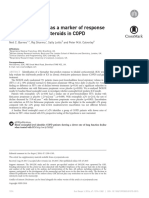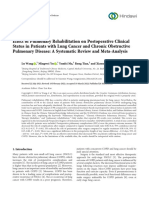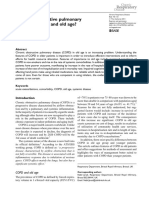TRD 70 323 1
TRD 70 323 1
Uploaded by
Nurul Ummah NuCopyright:
Available Formats
TRD 70 323 1
TRD 70 323 1
Uploaded by
Nurul Ummah NuOriginal Title
Copyright
Available Formats
Share this document
Did you find this document useful?
Is this content inappropriate?
Copyright:
Available Formats
TRD 70 323 1
TRD 70 323 1
Uploaded by
Nurul Ummah NuCopyright:
Available Formats
DOI: 10.4046/trd.2011.70.4.323 ISSN: 1738-3536(Print)/2005-6184(Online) Tuberc Respir Dis 2011;70:323-329 Copyright2011.
The Korean Academy of Tuberculosis and Respiratory Diseases. All rights reserved.
Original Article
Differences between Patients with TB-Destroyed Lung and Patients with COPD Admitted to the ICU
Young Kyeong Seo, M.D., Chae Hun Lee, M.D., Hyun-Kyung Lee, M.D., Young Min Lee, M.D., Hye Kyeong Park, M.D., Sang Bong Choi, M.D., Hyun Gook Kim, M.D., Hang-Jea Jang, M.D., Ho-Kee Yum, M.D., Seung Heon Lee, M.D. Division of Pulmonary and Critical Care Medicine, Department of Internal Medicine, Inje University College of Medicine, Busan, Korea
Background: Although patients with tuberculous-destroyed lung (TDL) account for a significant proportion of those with chronic airflow obstruction, it is difficult to distinguish patients with airway obstruction due to TDL from patients with pure chronic obstructive pulmonary disease (COPD) on initial presentation with dyspnea. We investigated clinical features differing between (i) patients with TDL and airway obstruction and (ii) those with COPD admitted to the intensive care unit (ICU) due to dyspnea. Methods: We reviewed the medical records of patients with TDL who had a forced expiratory volume in 1 second (FEV1)/forced vital capacity (FVC) of 70% on a pulmonary function test (PFT; best value closest to admission) and patients with COPD without a history of pulmonary tuberculosis (TB) who were admitted to the ICU. Ultimately, 16 patients with TDL and 16 with COPD were compared, excluding patients with co-morbidities. Results: The mean ages of the patients with TDL and COPD were 63.7 and 71.2 years, respectively. Mean FVC% (50.4% vs. 71.9%; p0.01) and mean FEV1% (39.1% vs. 58.4%; p0.01) were significantly lower in the TDL group than in the COPD group. More frequent consolidation with TB (68.8% vs. 31.3%; p=0.03) and more tracheostomies (50.0% vs. 0.0%; p=0.02) were observed in the TDL than in the COPD group. Conclusion: Upon ICU admission, patients with TDL had TB pneumonia more frequently, more diminished PFT results, and more tracheostomies than patients with COPD. Key Words: Tuberculosis, Pulmonary; Lung Diseases, Obstructive; Pulmonary Disease, Chronic Obstructive; Intensive Care Units
Introduction
The term 'tuberculous-destroyed lung (TDL)' is usually used to describe the destructive lung parenchymal changes due to sequelae of pulmonary tuberculosis, which occur over years, and cause chronic airway obstruction as well as restrictive change. In South Korea, tuberculosis (TB) burden is intermediate (88/100,000)
Address for correspondence: Seung Heon Lee, M.D. Division of Pulmonary and Critical Care Medicine, Department of Internal Medicine, Busan Paik Hospital, Inje University College of Medicine, 633-165, Gaegum-2-dong, Jin-gu, Busan 614-735, Korea Phone: 82-51-890-6959, Fax: 82-51-892-0273 E-mail: leesh@inje.ac.kr Received: Jan. 27, 2011 Accepted: Apr. 11, 2011
and complications from TB are still an important pulmo1 nary disorder , but clinical manifestations of TDL can be similar to those of chronic obstructive pulmonary disease (COPD) with manifestations of dyspnea due to airway obstruction. Furthermore, TDL may be a common cause of acute exacerbation with respiratory failure in South Korea2, but there are few predictive factors to suggest differences in the prognosis between patients with TDL and those with COPD when patients with dyspnea, caused by aggravation of airway obstruction, are admitted to intensive care unit (ICU) until now. Chronic bronchitis or bronchilolitis and emphysema can occur as complications of pulmonary TB, and the degree of airway obstruction changes in subjects treated for TB; it increases with age, the number of cigarettes
323
YK Seo et al: TB-destroyed lung and COPD in ICU
smoked, and the extent of the initial TB disease . However, it is difficult to distinguish patients with airway obstruction due to TDL from patients with pure COPD on initial presentation with dyspnea. The suggested mechanism of airway obstruction in TDL is a sequela of tuberculosis, due to granulomatous changes in the bronchial wall, extrinsic pressure from enlarged peribronchial lymph nodes, or residual fibrotic endobron4 chial stenosis , while those of COPD are chronic inflammatory disease of the lungs, mostly in response to cigarette smoking5. TDL patients with acute respiratory failure and positive AFB smears have higher mortality rates than those with negative AFB6. Furthermore, patients with pulmonary TB presenting with dissemination are more likely to present with acute respiratory failure requiring mechanical ventilation and to have a worse prognosis than 7 patients with localized TB pneumonia . However, a radiological evaluation, including high-resolution computed tomography (HRCT), does not provide a definite clue to the differential diagnosis from bacterial pneumonia, so an early diagnosis can be delayed. In cases of COPD, mortality is related to the frequency of severe exacerbations requiring hospital care, and the presence of acute physiology and chronic health evaluation (APACHE) II-associated comorbidity and the need for mechanical ventilation 72 hours are 8 independent predictors of poor outcome . Although several published studies have focused on patients with active pulmonary TB and respiratory failure, few studies have attempted to identify the difference between patients with TDL and COPD who have respiratory failure symptoms. Thus, the aim of this study was to identify differences in the clinical features between patients with TDL and COPD who were admitted to ICU due to dyspnea.
without a TB history who had an obstructive pattern on a pulmonary function test. They were all admitted to the ICU of a Busan Paik University-Affiliated Hospital via the emergency room due to dyspnea between October 2004 and May 2009. The patients with accumulated available pulmonary function test results with less than 70% of forced expiratory volume in 1 second/forced vital capacity (FEV1/FVC) were selected (best value closest to admission day), and patients who had co-existing pulmonary or cardiovascular diseases were excluded. Initially 38 patients with TDL and 39 with COPD were selected according the above criteria, but patients with underlying diseases such as malignancy, heart failure, and chronic renal failure as well as previously unconfirmed patients with COPD were excluded from the final analysis. Also, patients who had a comorbidity other than an airway obstruction, such as a pneumothorax, massive hemoptysis, and pleural effusion, which could confound the dyspnea caused by airway obstruction, were excluded. Sixteen patients with TDL and 16 patients with COPD were finally enrolled, and we analyzed demographic data, pulmonary function test results, arterial blood gases, blood chemistry, radiological characteristics, APACHE II sores, combined medical problems on admission, total ventilation time, and final outcome in the ICU.
1. Definition of TDL and COPD
We defined patients with TDL as those presenting with lung function insufficiency due to previous pulmonary TB, parenchymal damage to more than one lung lobe, no recent evidence of active TB, less than 20 pack-years smoking history, and no current smoking habit9. For COPD, we followed the definition of the 10 Global Initiative for Chronic Obstructive Lung Disease .
Materials and Methods
We reviewed the medical records of patients with TDL and a TB history, who had an obstructive pattern on a pulmonary function test and patients with COPD
2. Statistical analysis
The SPSS version 12.0 (SPSS Inc., Chicago, IL, USA) software was used for all statistical analyses. The chi-squared test or Fisher's exact test was used for categorical variables. The student t-test for pulmonary func-
324
Tuberculosis and Respiratory Diseases Vol. 70. No. 4, Apr. 2011
tion tests and the Mann-Whitney test for other continuous variables were used. Statistical significance was defined as a p-value 0.05.
Results
1. Clinical characteristics of the patients with TDL and COPD
Thirty-two subjects were finally analyzed in the study (Table 1). The mean ages of the patients with TDL and COPD were 63.7 and 71.2 years, respectively. The 2 mean body mass index (BMI) was 19.7 and 21.8 kg/m , respectively, showing that the patients were in a malnourished state. All patients with COPD had a smoking history of more than 20 pack-years, while none of the patients with TDL did. No difference was observed between the two groups for compliance with regular follow-up in the outpatient clinic before admission. Patients with TDL had no more frequent admission histories than patients with COPD (50.0% vs. 68.7%), and patients with TDL were admitted to hospital as frequently as patients with
COPD (mean admission frequency, 1.4 times vs. 3.6 times, respectively). Emphysematous changes on a chest CT were seen in 14 of 16 patients (87.5%) in the TDL group and in 9 of 16 patients (56.3%) in the COPD group all with multi-lobe involvement. The frequency of blood-tinged sputum and chest pain tended to be higher in the patients with TDL than in those with COPD, but the difference was not significant.
2. Differences between patients with TDL and patients with COPD
As shown in Table 2, the predicted FEV1/FVC (%) was similar in the two groups (55.0% vs. 55.2%), but the mean FVC predicted value was significantly lower in patients with TDL than in those with COPD (50.4% vs. 71.9%; p0.01), and FEV1 values were significantly lower in patients with TDL than in those with COPD (39.1% vs. 58.4%; p0.01). When a positive bronchodilator response which was officially defined as an absolute change in FEV1 of more than 200 mL and a per11 centage of initial FEV1 of more than 12% was applied ,
Table 1. Clinical characteristics in patients with tuberculosis destroyed lung (TDL) and chronic obstructive pulmonary disease (COPD)
TDL (n=16) Age, yr* Gender, MF Smoking, 20 PY (%) 2 Body mass index, kg/m * Previous TB history Admission history Mean frequency of admission Emphysema on CT One lobe Multi lobe Clinical presentation Dyspnea Blood-tinged sputum Chest pain Purulent sputum Wheezing 63.714.3 124 0 (0.0) 19.73.6 16 (100.0) 8 (50.0) 1.4 14 (87.5) 0 14 16 2 7 2 6 (100.0) (12.5) (43.8) (12.5) (37.5) COPD (n=16) 71.29.6 115 12/16 (75.0) 21.83.7 0 (0.0) 11 (68.7) 3.6 9 (56.3) 0 9 16 1 5 4 4 (100.0) (6.3) (31.3) (25.0) (25.0) p-value 0.11 1.00 0.01 0.21 0.01 0.28 0.11 0.11
1.00 1.00 0.53 0.65 0.70
Values are presented as number (%) unless otherwise indicated. *Values are presented as meanSD. M: male; F: female; PY: pack year; TB: tuberculosis; CT: computed tomography; SD: standard deviation.
325
YK Seo et al: TB-destroyed lung and COPD in ICU
Table 2. Comparison between patients with tuberculosis destroyed lung (TDL) and chronic obstructive pulmonary disease (COPD)
TDL (n=16) Pulmonary function tests FVC, %* FEV1, %* FEV1/FVC, %* () Bronchodilator response, n (%) Consolidation on CXR, n (%) Multi lobe AFB S/C , n (%) Shock on admission, n (%) AaDO2 ,mm Hg PaO2/FiO2, ratio PaCO2 mm Hg APACHE II, score Mechanical ventilation, n (%) Tracheostomy, n (%) Total ventilation time, hr Stay in intensive care unit, day Mean arterial pressure, mm Hg Albumin, g/dL BUN, mg/dL CRP, mg/dL WBC, 109/L Hematocrit, ratio Platelets, 109/L Steroid treatment, n (%) Survival, n (%) COPD (n=16) p-value 0.01 0.01 0.90 0.60 0.03 0.02 0.72 0.97 0.94 0.24 0.20 0.48 0.02 0.84 0.80 0.12 0.49 0.03 0.32 0.62 0.29 0.07 0.22 1.00
50.418.2 39.115.9 55.014.8 1 (6.3) 11 (68.8) 4 6 (37.5) 4 (25.0) 113.8122.5 238.690.5 54.925.4 14.48.2 8 (50.0) 4/8 (50.0) 150.6303.5 11.313.7 85.629.6 3.30.5 27.822.6 7.07.2 108.075.1 34.48.0 243.395.6 10 (62.5) 13 (81.3)
71.917.2 58.416.5 55.29.5 3 (18.8) 5 (31.3) 3 0 (0.0) 5 (31.3) 87.450.7 234.861.9 44.721.1 16.83.9 10 (62.5) 0/10 (0.0) 64.671.4 8.37.9 76.218.5 3.10.8 51.544.2 15.116.1 116.573.7 37.47.8 183.382.3 14 (87.5) 14 (87.5)
Values are presented as meanSD unless otherwise indicated. *Values are percent of predicted value, Among the patients under mechanical ventilation. FVC: forced vital capacity; FEV1: forced expiratory volume in 1 second; AFB: acid-fast bacilli; S/C: smear/culture; AaDO2: alveolar-arterial oxygen difference; APACHE II: acute physiology and chronic health evaluation II; BUN: blood urea nitrogen; CRP: c-reactive protein; WBC: white blood cell.
the positive rates were 6.3% in patients with TDL and 18.8% in those with COPD, respectively. Consolidation was more frequently found on X-ray in patients with TDL than in those with COPD (68.8% vs. 31.3%; p=0.03), and 6 of 16 patients (37.5%) with TDL were confirmed as recurrent pulmonary TB with a positive AFB smear and culture results, which was a significantly higher rate than patients with COPD (37.5% vs. 0%; p=0.02). No significant difference was observed for PaO2/FiO2 ratio between patients with TDL and COPD. The PaCO2 tended to be higher in patients with TDL (54.925.4) than in those with COPD (44.721.1), but the differ-
ence was not significant. Also, APACHE II scores were not different between two groups. A ventilator was used in 8 of 16 patients (50.0%) in the TDL group, and 10 of 16 patients (62.5%) in the COPD group, among which non invasive ventilation was used in 1 COPD patient. Four patients in the TDL group underwent a tracheostomy, and the procedure was performed at an average of 10.5 days after intubation. ICU stay days and total ventilation time were longer in the TDL group than the COPD group without statistical significance. Mean arterial pressures were not different between the TDL group and the COPD group (85.629.6 mm Hg vs.
326
Tuberculosis and Respiratory Diseases Vol. 70. No. 4, Apr. 2011
76.218.5 mm Hg), but blood urea nitrogen was significantly lower in the TDL group than in the COPD group (27.822.6 mg/dL vs. 51.544.2 mg/dL; p= 0.03). The main cause of dyspnea in patients with TDL was thought to be an exacerbation of chronic airway obstruction, aggravated by associated respiratory infection, mostly manifesting as a pneumonic consolidation on chest X-ray. Among patients with TDL, wheezing sounds were audible among 6 of 16 patients (37.5%), and steroids were used in 10 of 16 (62.5%) patients at initial presentation. The survival rate was not different between the two groups (81.3% vs. 87.5%), and the cause of mortality of TDL patients (n=3) and COPD patients (n=2) were multi organ failure due to septic shock alike.
Discussion
The pulmonary function test results of patients with TDL were more severely diminished than those of patients with COPD. In addition, the patients with TDL had TB pneumonia more frequenctly and more tracheostomies than patients with COPD in ICU setting. This study identified differences between patients with TDL and COPD upon ICU admission excluding patients with underlying disease such as heart failure and renal failure, which is different from previous studies that described lung functions of patients in out-patients set9 ting . Loss of lung volume in patients with TDL can be explained in view of the destructive and fibrosing properties of pulmonary TB causing pulmonary overdisten3 tion . The obstructive lung disease might be attributable to TB involvement of the bronchial tree, with endobron12 chial inflammation , bronchiectatic lesions caused by 13 TB , or emphysematous parenchymal changes by traction due to extensive scarring14,15. In our study, all of 16 patients with TDL actually had emphysema with TB scar and fibrotic changes instead of pure emphysema on HRCT scan. Furthermore, the lower positive bronchodilator response rates in patients with TDL may be
due to the irreversibility of anatomical airway constriction in TDL. Therefore, the stay time in the ICU tended to be longer in patients with TDL than in patients with COPD, because weaning was more difficult in patients with TDL. In our study, a tracheostomy had been performed on four patients of TDL; decision for tracheostomy after day 10 of mechanical ventilation was made by full-time critical care physicians who followed 16 the weaning protocol . Increased elastic and restrictive work loads must have contributed to difficult weaning in the patients with TDL as with the patients with 17 COPD, but the main mechanism is unknown . Additionally, when we analyzed the patients with similar PFT values categorized by 3080% of the FEV1 value, there were no additional clinical differences between TDL group (n=11) and COPD group (n=13) except platlet count (255.489.2109/L versus 187.183.0109/L, p=0.04). In our study, the main pathogens for pneumonic consolidation were S. pneumoniae, P. aerosinosa, and K. pneumonia without difference between the TDL group and COPD group, but as many as 6 of 16 TDL patients were confirmed with recurrent pulmonary TB. Because TB pneumonia may frequently be indistinguishable from bacterial pneumonia, the diagnosis is generally made later. TB pneumonia more commonly occurs in older patients and in immunocompromised individuals, such as those with diabetes mellitus, cancer or infection with human immunodeficiency virus18,19. In our results, consolidation was predominantly observed in anatomically distorted areas induced by extensive TB scaring, especially in patients with TDL. Thus, it must be remembered that in patients with TDL and airflow obstruction, manifesting dyspnea, for whom intensive cares are needed, aggressive diagnostic strategy should be considered to exclude TB reactivation, especially in cases with consolidation. Frame et al. reported that the mortality rate for patients with TB and respiratory failure was 81%, and that 20 of patients with TB requiring intensive care was 67% . But, in our study, none of the six recurrent patients with TB in TDL requiring intensive care died. Compared with
327
YK Seo et al: TB-destroyed lung and COPD in ICU
a previous study , the reason for the lower mortality rate of these patients could be due to the lack of a smoking history, no underlying heart disease, and a smaller extent of lung destruction in our patients. To appreciate our results correctly, we should consider several limitations of the study. First, the number of cases involved was small. Second, co-existing asthma could not be completely excluded in either group. Lastly, not all patients were under ventilator care in the ICU. Therefore, prospective and larger studies are needed to clarify the main mechanism and the characteristics of dyspnea exacerbation in patients with TDL and COPD. In conclusion, TB pneumonia must be ruled out in patients with TDL, presenting with dyspnea exacerbation due to airflow obstruction, and more severe restriction and obstruction of pulmonary function, with a tendency for a longer ICU stay, are evident in patients with TDL versus those with COPD.
21
7.
8.
9.
10.
11.
12.
Acknowledgements
13.
The study was supported by a grant from Inje University in 2009.
References
1. World Health Organization. WHO Report 2008: global tuberculosis control - surveillance, planning, financing. Geneva: World Health Organization; 2008. 2. Hong SB, Oh BJ, Kim YS, Kang EH, Kim CH, Park YB, et al. Characteristics of mechanical ventilation employed in intensive care units: a multicenter survey of hospitals. J Korean Med Sci 2008;23:948-53. 3. Snider GL, Doctor L, Demas TA, Shaw AR. Obstructive airway disease in patients with treated pulmonary tuberculosis. Am Rev Respir Dis 1971;103:625-40. 4. Choe KO, Jeong HJ, Sohn HY. Tuberculous bronchial stenosis: CT findings in 28 cases. AJR Am J Roentgenol 1990;155:971-6. 5. Cosio BG, Agust A. Update in chronic obstructive pulmonary disease 2009. Am J Respir Crit Care Med 2010; 181:655-60. 6. Park JH, Na JO, Kim EK, Lim CM, Shim TS, Lee SD,
14.
15.
16.
17.
18.
19.
et al. The prognosis of respiratory failure in patients with tuberculous destroyed lung. Int J Tuberc Lung Dis 2001;5:963-7. Penner C, Roberts D, Kunimoto D, Manfreda J, Long R. Tuberculosis as a primary cause of respiratory failure requiring mechanical ventilation. Am J Respir Crit Care Med 1995;151:867-72. Soler-Catalua JJ, Martnez-Garca MA, Romn Snchez P, Salcedo E, Navarro M, Ochando R. Severe acute exacerbations and mortality in patients with chronic obstructive pulmonary disease. Thorax 2005;60:925-31. Lee JH, Chang JH. Lung function in patients with chronic airflow obstruction due to tuberculous destroyed lung. Respir Med 2003;97:1237-42. Rabe KF, Hurd S, Anzueto A, Barnes PJ, Buist SA, Calverley P, et al. Global strategy for the diagnosis, management, and prevention of chronic obstructive pulmonary disease: GOLD executive summary. Am J Respir Crit Care Med 2007;176:532-55. Pellegrino R, Viegi G, Brusasco V, Crapo RO, Burgos F, Casaburi R, et al. Interpretative strategies for lung function tests. Eur Respir J 2005;26:948-68. Martin CJ, Cochran TH, Katsura S. Tuberculosis, emphysema, and bronchitis. Am Rev Respir Dis 1968;97: 1089-94. Rosenzweig DY, Stead WW. The role of tuberculosis and other forms of bronchopulmonary necrosis in the pathogenesis of bronchiectasis. Am Rev Respir Dis 1966;93:769-85. Im JG, Itoh H, Lee KS, Han MC. CT-pathology correlation of pulmonary tuberculosis. Crit Rev Diagn Imaging 1995;36:227-85. Katz J, Kunofsky S. Tuberculosis as a cause of the increasing mortality from emphysema. Am Rev Respir Dis 1964;89:673-9. MacIntyre NR, Cook DJ, Ely EW Jr, Epstein SK, Fink JB, Heffner JE, et al. Evidence-based guidelines for weaning and discontinuing ventilatory support: a collective task force facilitated by the American College of Chest Physicians; the American Association for Respiratory Care; and the American College of Critical Care Medicine. Chest 2001;120(6 Suppl):375S-95S. Gladwin MT, Pierson DJ. Mechanical ventilation of the patient with severe chronic obstructive pulmonary disease. Intensive Care Med 1998;24:898-910. Lee SH, Hur GY, Jung KH, Lee SY, Lee SY, Kim JH, et al. Clinical Investigation of Tuberculous Pneumonia. Tuberc Respir Dis 2004;57:19-24. Choi D, Lee KS, Suh GY, Kim TS, Kwon OJ, Rhee CH,
328
Tuberculosis and Respiratory Diseases Vol. 70. No. 4, Apr. 2011
et al. Pulmonary tuberculosis presenting as acute respiratory failure: radiologic findings. J Comput Assist Tomogr 1999;23:107-13. 20. Frame RN, Johnson MC, Eichenhorn MS, Bower GC, Popovich J Jr. Active tuberculosis in the medical intensive care unit: a 15-year retrospective analysis. Crit
Care Med 1987;15:1012-4. 21. Lin SM, Wang TY, Liu WT, Chang CC, Lin HC, Liu CY, et al. Predictive factors for mortality among non-HIVinfected patients with pulmonary tuberculosis and respiratory failure. Int J Tuberc Lung Dis 2009;13:335-40.
329
You might also like
- CT ScanDocument23 pagesCT ScanekaNo ratings yet
- Post Tubercular Obstructive Airway Impairment: Review ArticleDocument5 pagesPost Tubercular Obstructive Airway Impairment: Review ArticleZakia ImaniNo ratings yet
- Treatment Outcome Among Post TB Obstructive Airways Diseases and COPDDocument6 pagesTreatment Outcome Among Post TB Obstructive Airways Diseases and COPDdyahNo ratings yet
- 2° Artículo de EpocDocument10 pages2° Artículo de EpocveroarujogonzalesNo ratings yet
- Copd Nihilismo BuenisimoDocument8 pagesCopd Nihilismo BuenisimoJose Lopez FuentesNo ratings yet
- Relationship Between Lung Functions and Extend of Emphysema in Patients With Chronic Obstructive Pulmonary Disease 2161 105X.1000191Document5 pagesRelationship Between Lung Functions and Extend of Emphysema in Patients With Chronic Obstructive Pulmonary Disease 2161 105X.1000191Trhy Rahyou MarbaniatyNo ratings yet
- CCRPM 2011 001 PDFDocument5 pagesCCRPM 2011 001 PDFAlexandria Firdaus Al-farisyNo ratings yet
- Impairment Impaimet TBDocument12 pagesImpairment Impaimet TBDoddy KurniawanNo ratings yet
- COPD and Pulmonary Thromboembolism (For Galley Proof)Document6 pagesCOPD and Pulmonary Thromboembolism (For Galley Proof)Ram AdhikariNo ratings yet
- Chronic Obstructive Pulmonary DiseaseDocument7 pagesChronic Obstructive Pulmonary DiseaseDeka AdeNo ratings yet
- Full ArticleDocument8 pagesFull Articlekbrown733No ratings yet
- Emfisema - Pulmo FunctionDocument8 pagesEmfisema - Pulmo FunctionermanmahendraNo ratings yet
- Imaging in Chronic Obstructive Pulmonary DiseaseDocument9 pagesImaging in Chronic Obstructive Pulmonary DiseaseHarizNo ratings yet
- CopdDocument9 pagesCopdMande ariatiNo ratings yet
- Jurnal SOPTDocument10 pagesJurnal SOPTAnonymous Skzf3D2HNo ratings yet
- Presented By: Ima Sulistiyo RDocument18 pagesPresented By: Ima Sulistiyo RjackytungadiNo ratings yet
- Metoprolol y El EPOCDocument10 pagesMetoprolol y El EPOCMadyurit RamírezNo ratings yet
- Post-Tuberculous Chronic Obstructive Pulmonary Disease: Clinical Practice ArticleDocument3 pagesPost-Tuberculous Chronic Obstructive Pulmonary Disease: Clinical Practice ArticleAjeng SekariniNo ratings yet
- Gold Criteria For COPDDocument8 pagesGold Criteria For COPDmrppserodio7856No ratings yet
- Atm 09 05 390Document14 pagesAtm 09 05 390Adistha Eka Noveyani,No ratings yet
- Effect of Acbt & Postural Tapping On Fev1 &Fev1/Fvc in Moderate To Severe Copd PatientDocument6 pagesEffect of Acbt & Postural Tapping On Fev1 &Fev1/Fvc in Moderate To Severe Copd PatientManasvi MathurNo ratings yet
- Pulmonary Function TestDocument3 pagesPulmonary Function Testhm3398No ratings yet
- Ijam 1Document5 pagesIjam 1Chakradhar ChakrreNo ratings yet
- Resultados en Pacientes Con FPI Avanzada Tratados Con Nintedanib y PirfenidonaDocument8 pagesResultados en Pacientes Con FPI Avanzada Tratados Con Nintedanib y PirfenidonajosealexandercabrerakingsleyNo ratings yet
- Title Sputum Bacteriology in Patients With Severe Chronic Lung DiseasesDocument47 pagesTitle Sputum Bacteriology in Patients With Severe Chronic Lung DiseasesHam FGNo ratings yet
- Analysis of Patients With Hemoptysis in A Tertiary Referral HospitalDocument8 pagesAnalysis of Patients With Hemoptysis in A Tertiary Referral HospitalNadia Mrz Mattew MuseNo ratings yet
- Harshal ThesisDocument75 pagesHarshal ThesisAdityaRahaneNo ratings yet
- Coagulation Dysfunction in Patients With AECOPD and ItsDocument6 pagesCoagulation Dysfunction in Patients With AECOPD and ItsAndreea MoalesNo ratings yet
- COPDDocument32 pagesCOPDkingomustafa6No ratings yet
- Hub TBC DG CopdDocument7 pagesHub TBC DG CopdAmalNo ratings yet
- COPD Updated Guidelines and Newer TherapiesDocument90 pagesCOPD Updated Guidelines and Newer TherapiesVlad Constantin100% (1)
- Diffusing Capacity of Carbon Monoxide in Assessment of COPD: Original ResearchDocument9 pagesDiffusing Capacity of Carbon Monoxide in Assessment of COPD: Original ResearchKlinikdr RIDHANo ratings yet
- EBM COPD Dan Gagal Napas - EditDocument57 pagesEBM COPD Dan Gagal Napas - EditNiarti Ulan Sari SiarnuNo ratings yet
- Pertanyaan 7Document14 pagesPertanyaan 7WicakNo ratings yet
- Jurnal TuberkulosisDocument12 pagesJurnal TuberkulosisviviavisaNo ratings yet
- EfwefrgDocument13 pagesEfwefrgAbd Halim Gazali HNo ratings yet
- A Case Presentation On Chronic Obstructive Disease (COPD)Document18 pagesA Case Presentation On Chronic Obstructive Disease (COPD)Harvey T. Dato-onNo ratings yet
- 105 FullDocument7 pages105 FullMohamad Fiqih ArrachmanNo ratings yet
- Jurnal Perawatan PaliatifDocument16 pagesJurnal Perawatan Paliatifnurwanda hamidaNo ratings yet
- Management of Acute Exacerbation of Copd: Dr. Fanny WS KoDocument3 pagesManagement of Acute Exacerbation of Copd: Dr. Fanny WS KoCalca NeusNo ratings yet
- Ventilation With A Low Tidal Volume vs. An Intermediate Tidal Volume During Pleural DecorticationDocument9 pagesVentilation With A Low Tidal Volume vs. An Intermediate Tidal Volume During Pleural DecorticationAfridatul LuailiyahNo ratings yet
- Epidemiology of Asthma Chronic Obstructive Pulmonary Disease OverlapDocument15 pagesEpidemiology of Asthma Chronic Obstructive Pulmonary Disease Overlapsergio salazarNo ratings yet
- CAM Therapies For Symptoms Management of Asthma and COPDDocument14 pagesCAM Therapies For Symptoms Management of Asthma and COPDCharlyn MoellersNo ratings yet
- Obstructive Sleep Apnea in Chronic Obstructive PulmonaryDocument5 pagesObstructive Sleep Apnea in Chronic Obstructive PulmonaryGeorge Cătălin AlexandruNo ratings yet
- Understanding Copd-Overlap SyndromesDocument63 pagesUnderstanding Copd-Overlap SyndromesGeorge Cătălin AlexandruNo ratings yet
- New England Journal Medicine: The ofDocument12 pagesNew England Journal Medicine: The ofAndre MaulanaNo ratings yet
- RCT - UpliftDocument12 pagesRCT - Upliftbapimirab654No ratings yet
- Print 1Document8 pagesPrint 1Zaura Meliana MulyadiNo ratings yet
- PulmDocument5 pagesPulmShikya AbnasNo ratings yet
- Chronic Obstructive Pulmonary Disease Diagnosis and StagingDocument50 pagesChronic Obstructive Pulmonary Disease Diagnosis and StagingSensing NonsenseNo ratings yet
- PreventionDocument3 pagesPreventioncarloscano1994No ratings yet
- COPD2019Document9 pagesCOPD2019ClintonNo ratings yet
- CopdDocument7 pagesCopdMelinda Anzani PutriNo ratings yet
- 1374 FullDocument9 pages1374 FullElendisNo ratings yet
- Doença Pulmonar Obstrutiva Crônica Comórbida e Insuficiência Cardíaca Fatores de Risco Compartilhados e Oportunidades para Melhorar Os ResultadosDocument3 pagesDoença Pulmonar Obstrutiva Crônica Comórbida e Insuficiência Cardíaca Fatores de Risco Compartilhados e Oportunidades para Melhorar Os Resultadosmayanna.santosNo ratings yet
- Artículo PulmonarDocument9 pagesArtículo PulmonarSamuel GasparNo ratings yet
- Jarad 2011 Chronic Obstructive Pulmonary Disease (Copd) and Old AgeDocument9 pagesJarad 2011 Chronic Obstructive Pulmonary Disease (Copd) and Old AgeIrawaty Christin Marthyna SimanjuntakNo ratings yet
- Low Body Mass Index, Airflow Obstruction, and Dyspnoea in A Primary Care COPD Patient PopulationDocument6 pagesLow Body Mass Index, Airflow Obstruction, and Dyspnoea in A Primary Care COPD Patient PopulationArizal AbdullahNo ratings yet
- Diagnosis and Treatment of Chronic CoughFrom EverandDiagnosis and Treatment of Chronic CoughSang Heon ChoNo ratings yet


